|
 Inocybe leptospermi Inocybe leptospermi
SynonymsAstrosporina leptospermi
BiostatusPresent in region - Indigenous. Endemic
Images (click to enlarge)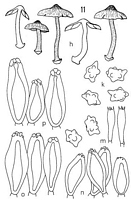
Caption: Astrosporina leptospermi (type): h, carpophores; k, spores; m, basidia; n, cheilocystidia; o,
pleurocystidia; p, caulocystidia, | 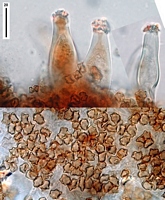
Caption: top: cheilocystidia. bottom: spores
Owner: J.A. Cooper | 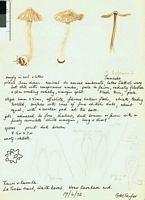
Caption: Watercolour
Owner: G.M. Taylor | 
Caption: ZT74-540
Owner: E. Horak: © Creative Commons Attribution-Noncommercial 3.0 New Zealand | 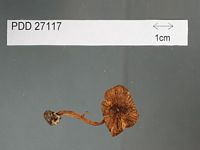
Caption: Dried type specimen
Owner: Herb PDD | 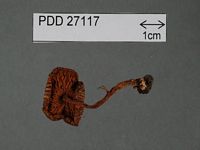
Caption: Dried type specimen
Owner: Herb PDD | 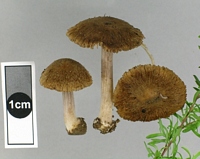
Owner: J.A. Cooper | 
Caption: 68/570: Inocybe leptospermi
Owner: Egon Horak | |
Article: Horak, E. (1978) [1977]. Fungi Agaricini Novaezelandiae. VI. Inocybe (Fr.) Fr. and Astrosporina Schroeter. New Zealand Journal of Botany 15(4): 713–747 (http://www.rsnz.org/publish/abstracts.php).
Description: Pileus-35 mm diam., conico-convex, campanulate
to umbonate-expanded; grey-brown, hazel-brown to dark brown, yellow tints absent;
umbo smooth later squamose, fibrillose to rimose towards the margin, often splitting;
subviscid when wet, veil remnants absent. Lamellae adnate, adnexed to almost
free, crowded (1-7), ventricose; whitish or grey when young turning beige-grey,
with white fimbriate edges. Stipe 25-50 x 3-5 mm, cylindrical with marginate
bulb (-11 mm diam.); whitish soon turning pink or reddish brown, bulb white
outside; pruinate, no veil remnants dry, solid, single in groups. Context brownish
in pileus, reddish brown in stipe. Odour not distinctive.
Spores 8-10 x 6-8 µm, nodulose, knobs conspicuous.
Basidia 22-30 x 6-8 µm, 4-spored. Cheilo-cystidia 30-45 x 12-18 µm, ovate to
subfusoid, metuloid (membrane -4 µm diam.), encrusted, hyaline. Pleurocystidia
32-60 x 15-25 µm, otherwise like cheilocystidia, also caulocystidia. Cuticle
a cutis of cylindrical hyphae (4-14 µm diam.), encrusted with yellow-brown pigment.
Clamp connections numerous.
Habitat: On soil under Leptospermum scoparium.
New Zealand.
Notes: This species is common under Leptospermum
scoparium (and probably also L. ericoides) under different ecological
conditions. The most distinctive characters are the rather small, metuloid and
crystal-bearing cheilo- and pleurocystidia.
|